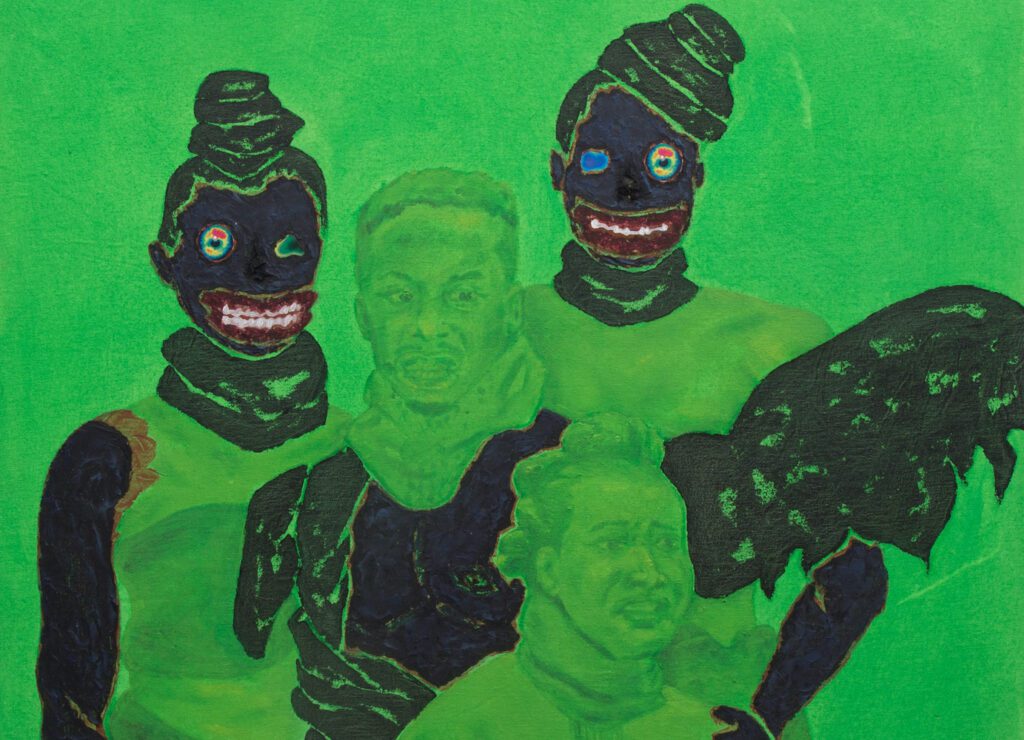Unveiling the Unsettling Beauty: Shoe Polish as a Medium
At first glance, Phetogo’s paintings arrest the viewer with their vivid colors and spectral black figures set against acid-green backdrops. However, a closer examination reveals the unsettling truth: he renders these figures partially with shoe polish—the same material once used by actors in blackface performances. This transformative act of using shoe polish guides the disarming, disquieting beauty of his work, but also raises an important question: what does it mean to place blackness on a figure?
Beyond Figuration: Exploring Identity and Representation
Phetogo’s artistic inquiry transcends traditional figuration or portraiture. It goes beyond merely capturing a likeness or representation. Instead, he delves into the deeper implications of participating in a conversation that has been growing louder and more urgent with time—a conversation about the historical and ongoing struggles of Black identity and self-representation.

A Self-Portrait with a Powerful Message: “A Portrait of the Subject Position at Onset”
One of Phetogo’s notable works, “A Portrait of the Subject Position at Onset” (2020), features a depiction of his own face smudged with beetle-like daubs of shoe polish. This painting is part of the landmark exhibition “When We See Us: A Century of Black Figuration in Painting,” currently on view at Cape Town’s Zeitz MOCAA. The show aims to prompt an internal evaluation of collective self-representation among Black artists.
Navigating Western-Dominated Discourse: Boldness in Conceptual Exploration
As a painter from Botswana operating within a Western-dominated discourse, Phetogo’s approach is undeniably bold. He acknowledges that his work may evoke discomfort, but he sees it as an essential acknowledgment that all is not right. However, his art is not confined to addressing societal issues. Phetogo revels in exploring conceptual wormholes, as seen in his “blackbody” series (2019–ongoing). Borrowing its name from a physics term for a hypothetical perfect entity that absorbs all electromagnetic radiation, the series allows Phetogo to delve deeper into subverting expectations while building a self-referential network of ideas.
The Unsettling “Propositions for the Origin of a blackbody”
In his latest body of work, “Propositions for the Origin of a blackbody,” Phetogo further embraces figurative abstractions. “Proposition 5 – Zombie Figuration, Painting 2” (2022) is a striking example, depicting a body turned inside-out with featureless eyes staring blankly ahead. The piece raises an intriguing question: Is it the subject of the portrait that classifies as the zombie, or are the ghosts of figuration itself haunting our perceptions of representation?
Conclusion: The Power of Art as a Catalyst for Critical Dialogue
Thebe Phetogo’s speculative and audacious approach to art challenges viewers to confront uncomfortable truths, historical injustices, and their role in the collective self-representation of Blackness. Through his use of shoe polish and figurative abstractions, Phetogo not only creates visually arresting art but also initiates critical conversations about identity, history, and the power of artistic expression. In doing so, he continues to be a trailblazing force in the contemporary art world, encouraging us all to reevaluate our own perceptions and biases.
Feature Image: Thebe Phetogo, blackbody Composites (Conjoined Twins) (Detail), 2020. Oil, acrylic, shoe polish and collage on canvas. Courtesy: contemporaryand
Dalit History Month Special: Celebrating the Art and Resistance of Dalit Artists

Contributor





